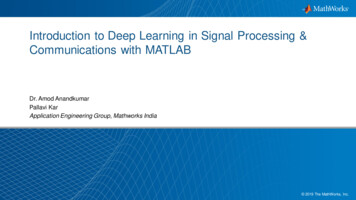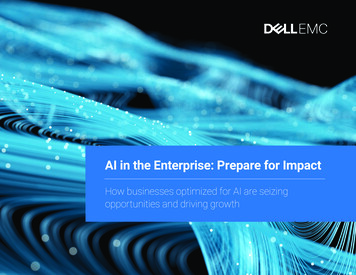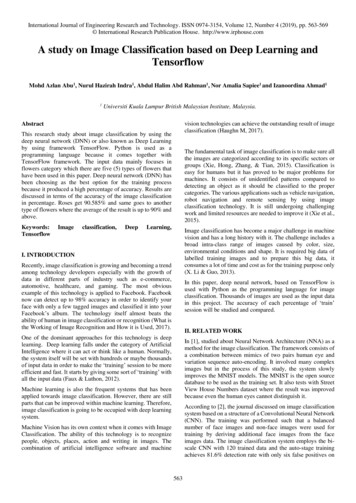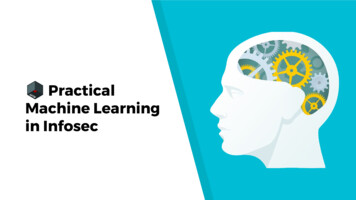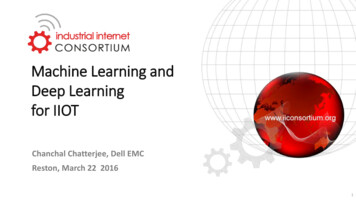
Transcription
Machine Learning andDeep Learningfor IIOTChanchal Chatterjee, Dell EMCReston, March 22 20161
Goals of the Meeting Provide insights on methods and systems for machinelearning and deep learning. Provide machine/deep learning use cases for IIOT. Provide architectures and frameworks formachine/deep learning for IIOT.2
Machine Learning & Deep Learning – Confusing, Eh!From Machine Learning Mastery (http://machinelearningmastery.com/)3
Machine Learning and Deep Learning Dependencies Types of Data Types of Learning Types of Algorithms4
Types of Data Structured Data Time Series Events Graph Unstructured Data Video/Images Voice Text5
Types of Learning Un-Supervised Do not require training data Assume normal instances far more frequentthan anomalies Semi-Supervised Training data has labeled instances for only thenormal class Assume normal instances far more frequentthan anomalies Supervised6
Types of Algorithms ML: Machine Learning Anomaly Detection Trends, Predictions & Forecasting Association & Grouping DL: Deep Learning Ladder NetworkConvolutional Neural NetworkRecurrent Neural NetworkDeep Belief Networks7
Some Details8
Machine Learning Anomaly Detection Point Anomaly Contextual Anomaly Collective Anomaly Graph Anomaly Trends, Predictions &Forecasting Associations & Grouping9
Deep Learning Ladder Network Convolutional NN (CNN) Recurrent NN (RNN) Recurrent Recursive NN (R2NN) Long Short Term Memory (LSTM) Deep Belief Networks (DBM) Restricted Boltzmann Machine(RBM)10
Deep Learning NetworksSource: http://www.asimovinstitute.org/neural-network-zoo/ 11
Small Fraction of Real-World ML Systems Have ML CodeFrom Hidden Technical Debt in Machine Learning SystemsScully et al, NIPS 201612
Manufacturing IoT Use CasesUse CasesDriversChallenges Predictive maintenance Process optimization Warehouse/supply chainoptimization Remote assetmaintenance andcontrol Product lifecyclemonitoring Integrated plantmanagement Product-as-a-service Increase yield/assetutilization New revenue streams Operational efficiencies Increased workersatisfaction/safety Eco-sustainability Low latencies Data security Interoperability between diverse setsof equipment (typically with their ownproprietary control system and datainterchange standard) Rapid interpretation of large volumesof data Reliable indoor/outdoor coverage inharsh environments Connectivity across different accesstechnologiesSource: SDx Central IoT Infrastructure Report 201713
IIoT Architectures14
Three Tier Deployment Model Takenfrom Industrial Internet Reference Architecture v1.815
Edge2Core Crosscutting Functions FromIIC Edge2Code TG16
IIOT Analytics Implementation Challenges How to Combine Streamingand Batch ProcessingFrameworks How to Introduce HumanDomain Knowledge NLP, Reinforced Learn, How to Distribute Processingand Data at the Tiers17
IIOT Analytics Implementation Challenges How to train DL withUnlabeled data usingAlgorithms & Domainknowledge How to scale DL intomultiple nodes How to tune DL Nws architecture, parameters18
IIOT End to End Frameworks Edge PlatformTierCollection &AggregationFrameworkFeature EngineeringStreamingFrameworkTierAnomaly DetectionDL Model ExecutionMachine Learning Framework (CPU?)IOIntensiveProcessedDataCom StorageCPU AttachedHumanDomain KnowledgeGPU Attached StorageModelsDeep Learning Framework eService Network19
Open Source Frameworks for MLand DL20
Deep Learning Frameworks Apache SINGABrainstormCaffeChainerCNTK (Microsoft)DL4JDMLCFbcunn (Facebook)Lasagne MinervaMocha.jl (Julia)MXnetNeon (Nervana)PurineTensorflow (Google)TheanoTorchWarp-CTC (Baidu) Brain (Javascript)CudamatDeep LearningFramework (Intel)DeepnetHebelInfer.NETKerasLeaf MLPNeuralNetNeural Network ift-AIVELES (Samsung)Each differ on – Licensing, Language implemented, OpenMP Support, OpenCL support, CUDAsupport, Various networks implemented, Pretrained model support and parallelimplementations 21
Deep Learning FrameworksStarted from Wikipedia22
TensorFlow for Deep Learning Open source library for Machine Learning and Deep Learning by Google. Supports CUDA, CNN, RNN and DBN. Distributed TensorFlow offers flexibility to scale up tohundreds of GPUs, train models with a huge number of parameters. Has a well documented Python API, less documented C and Java APIs. Uses XLA, JIT, AOT, and other compilation techniques to minimize execution time andmaximize computing resources. TensorBoard – Visualize TensorFlow graphs, monitor training performance, and explorehow models represent data. Layers, Estimators, and Canned Estimators for defining models. Keras DL framework can be used in Tensorflow. DeepMind also uses TensorFlow. TensorFlow models can be deployed in iOS and Android apps, and Raspberry Pi. TensorFlow Serving, a flexible, high-performance ML serving system designed forproduction environments. TensorFlow has a toolkit of ML algorithms.23
Apache Spark for Streaming and Machine Learning Open source library for SQL, Streaming, ML and Graph in a distributed cluster. Provides APIs for Scala, Java, Python and R. DAG execution engine supports acyclic data flow and in-memory computing. Runs on Hadoop, Mesos, standalone, or in the cloud. It can access diverse data sources including HDFS, Cassandra, HBase, Hive, and S3. Supports standalone (native Spark cluster), Hadoop YARN, or Apache Mesos. Spark Streaming has support built-in to consume from Kafka, Flume, Twitter, ZeroMQ, Kinesis, and TCP/IP sockets. Spark MLib simplifies large scale machine learning pipelines, including: Summary statistics, correlations, stratified sampling, hypothesis testing, random data generation[16]Classification and regression: support vector machines, logistic regression, linear regression, decision trees, naive BayesCollaborative filtering techniques including alternating least squares (ALS)Cluster analysis methods including k-means, and Latent Dirichlet Allocation (LDA)Dimensionality reduction techniques: singular value decomposition (SVD), and principal component analysis (PCA)Feature extraction and transformation functionsOptimization algorithms such as stochastic gradient descent, limited-memory BFGS (L-BFGS)GraphX is a distributed graph processing framework.24
THANK YOU25
TensorFlow for Deep Learning Open source library for Machine Learning and Deep Learning by Google. Supports CUDA, CNN, RNN and DBN. Distributed TensorFlow offers flexibility to scale up to hundreds of GPUs, train models with a huge number of parameters. Has a well documented Python API, less documented C and Java APIs.






